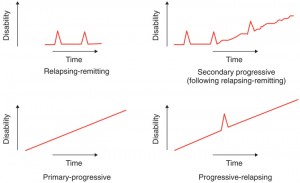TYPES OF MS
Let me remind you and myself with the old classification of MS which I think is not correct any more and must be updated in my view. The time is going on and moving forward, and we definitely need to move on with it if we seriously aim to beat MS. I think MS will be cured one day, and that day is not going to be too far to wait for. I have already heard high authority professionals in MS management saying that in about 8 – 10 years we will be able to cure MS. Within a decade or even may be less; it is not a long time to wait for !.
The old classification of MS was:
- Relapsing & remitting.
- Secondary progressive.
- Primary progressive.

Secondary progressive MS (SPMS) can be with or without relapses depending on the elapsed time and the degree of degeneration.
That classification was not correct in the beginning, and it is not correct anymore , because it was based on our old understanding of MS. I am talking about 40 – 50 years ago, during which a revolution in understanding MS has happened. The revolution in knowing more about MS was not reflected on its classification.
Let me show you this diagram to prove what I am talking about here:

There is nothing called secondary progressive MS de novo. Secondary progressive MS is obviously a secondary process following a primary one !. Secondary progressive type of MS can never be a separate class of MS. It is a process during which relapsing & remitting MS gets older and go deep through degeneration for it not to recover. It is when degeneration take over from inflammation, and that process is gradual. The time lapsed to reach that stage is difficult to predict i.e individual. There is always an interim phase during which both processes are combined i.e relapses & remissions with progression (SPMS with relapses. That mixture state may take some time before relapses cease and progression dominates.
Unfortunately, there is not a single test that tells us about the conversion (RRMS to SPMS), and it has to be a “clinical judgement” based on the course of events (history), but may be supported by increased MRI plaque load.
We can probably say in practice, there are only two types of MS:
- Relapsing & remitting MS, leading to secondary progressive MS of two types: a) SPMS with relapses. b) SPMS with no relapses.
- Primary progressive MS.
What about other forms of MS, such as the clinically isolated syndrome (CIS), Radiologically isolated syndromes(RIS), and the Benign MS(BMS) ?.
CIS is the first presentation of MS symptoms with radiological features are highly suggestive of MS, but the neurologist is unable to make a definite diagnosis of MS at that stage. That stage is called CIS, and in a good place with enough experience at least 50% will become definite MS in due time. I think that may be considered a separate class of MS.
Another type of MS presents in the beginning with symptoms suggestive of MS, and the MRI changes are classical of MS, but the patient remains very well with no significant progression over more than 10 years, with no new MRI changes, no relapses or hardly any one, and EDSS remains less than 2 ( I believe in EDDS 1.5 or less, but many authorities in the field of MS consider EDDS 2.5 or less). This BMS represents less than 5% of all MS.
It is fare to say that some MS authorities do not believe in something called BMS, and that view is very much respected. We need to do a proper research in this group of patients with very low EDSS, few demyelinating changes excluding spinal cord and cerebellum for at least 10 years. We could find out that those patients do represent a separate type of MS.
The latest classification of MS is:
- Relapsing MS
- Progressive MS (primary or secondary).
This new classification is very important when it comes to newer DMT which are used for progressive MS. Ocrelizumab (Ocrevus) is licensed for PPMS, but not for SPMS for no reason, but the research was done on PPMS !. Patients with SPMS should have access to this treatment if the pass the relapsing stage and their MS started to behave like PPMS.
